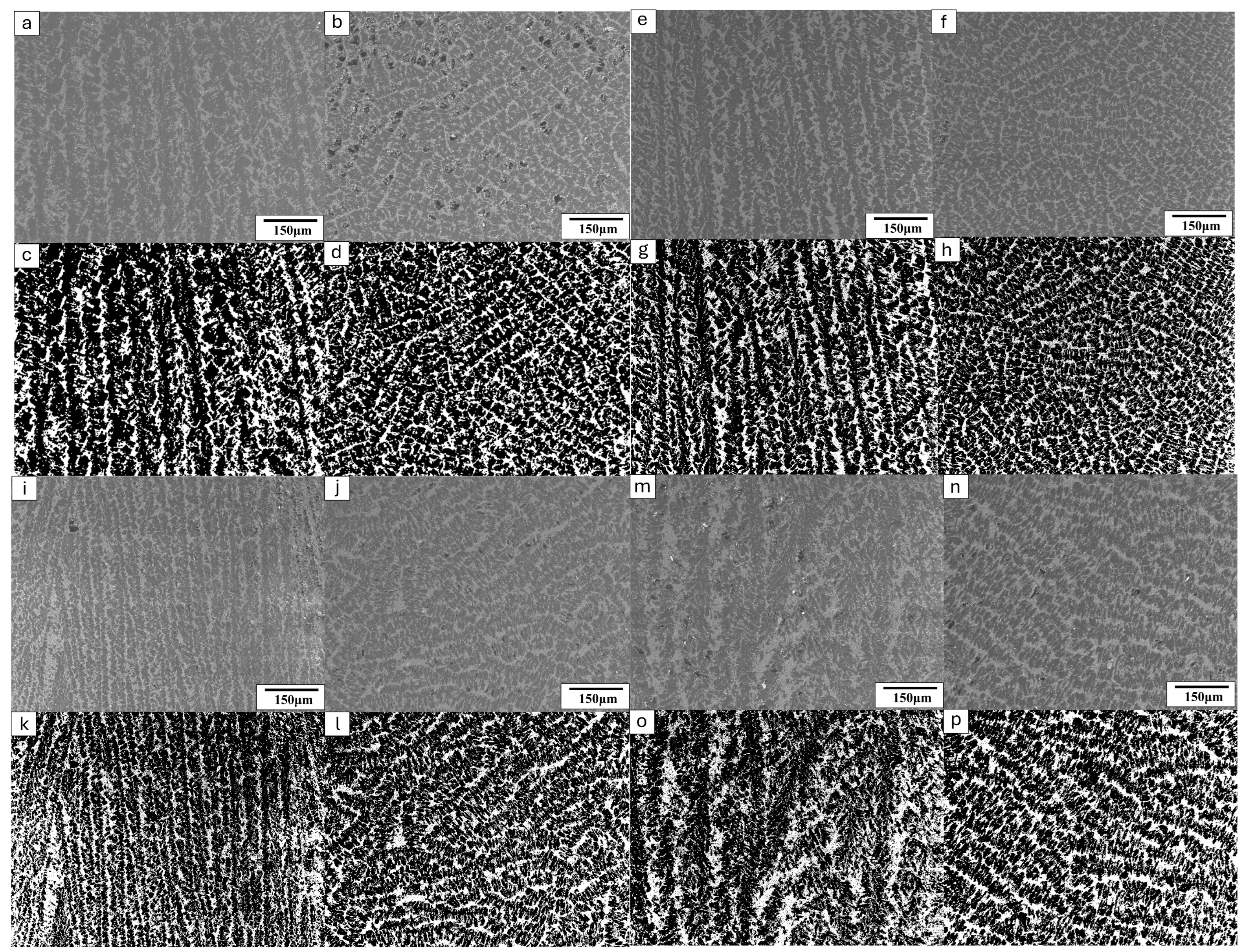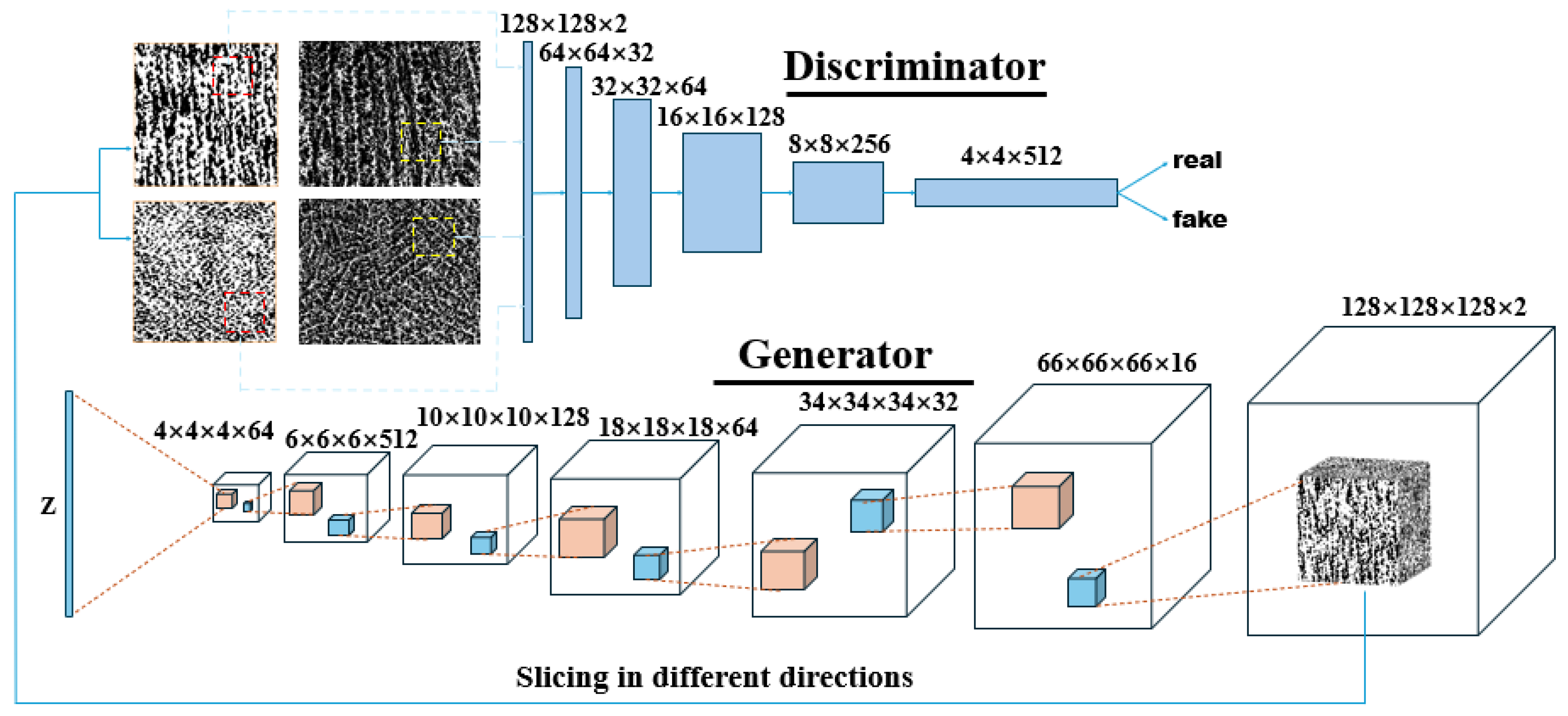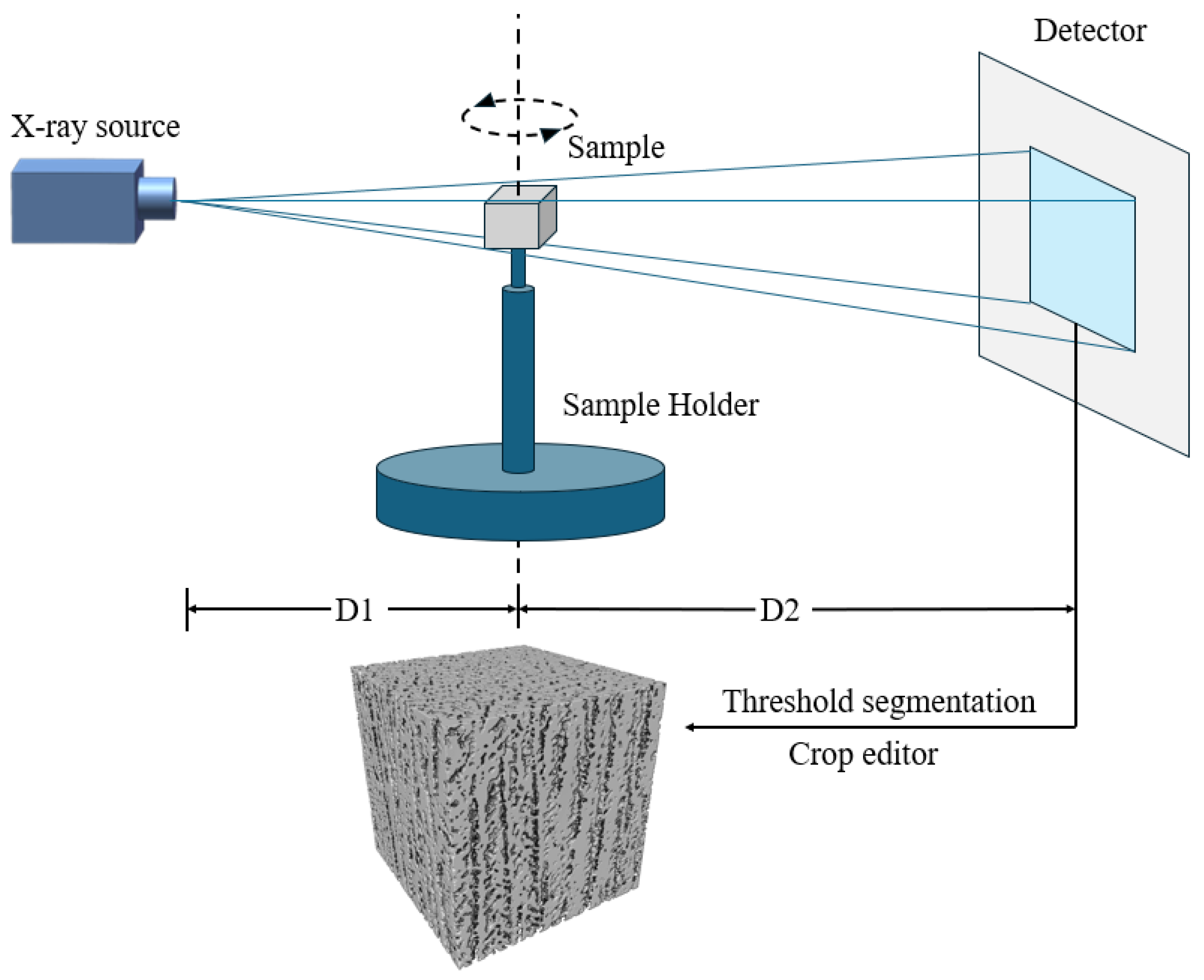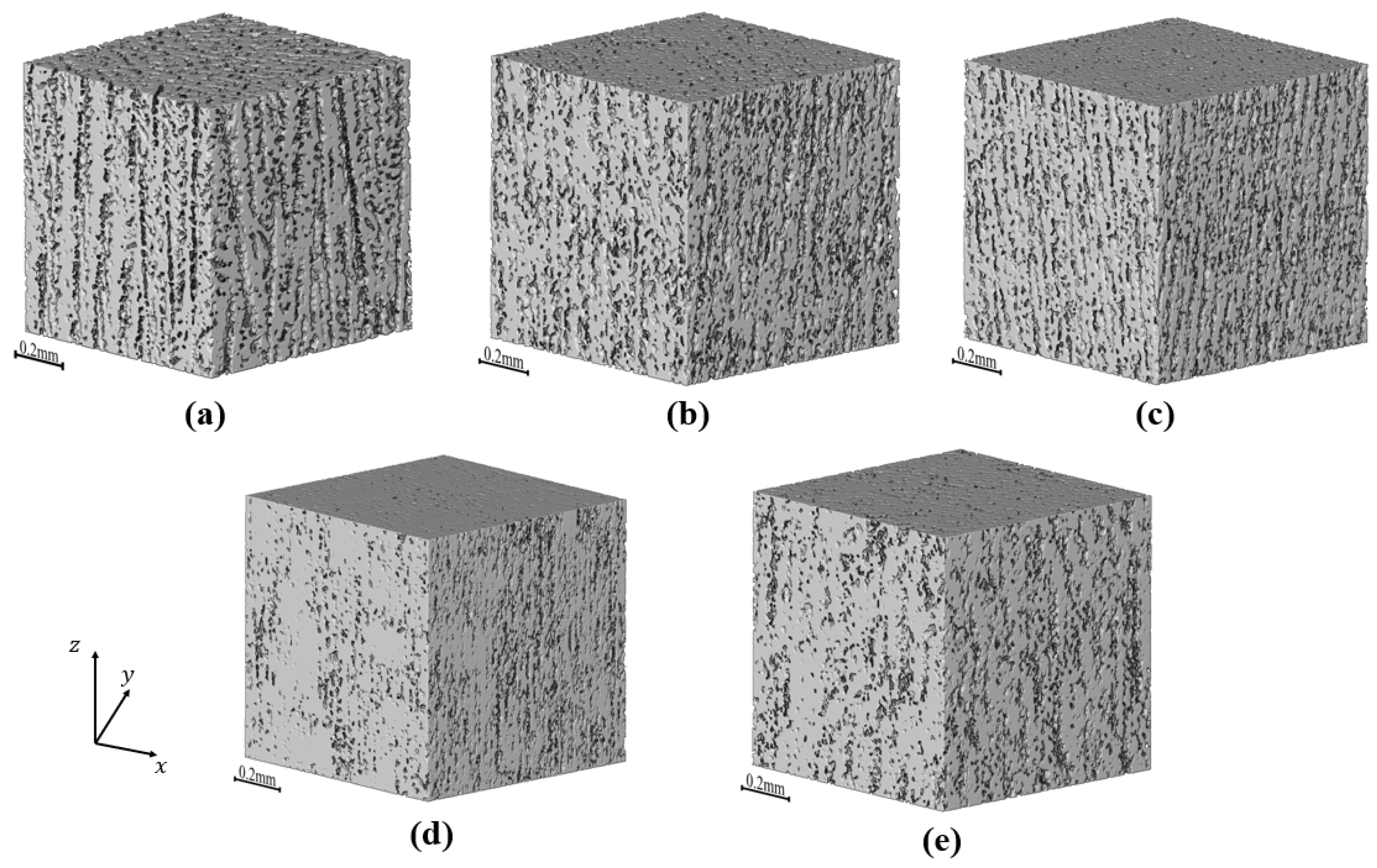Freeze-Casting of Alumina and Permeability Analysis Based on a 3D Microstructure Reconstructed Using Generative Adversarial Networks
Abstract
:1. Introduction
2. Materials and Methods
2.1. Preparation of the Slurry and Freeze Casting
2.2. Acquisition of Cross-Sectional SEM Images
2.3. Three-Dimensional Microstructure Reconstruction with Two-Dimensional SEM Images
2.4. X-ray Computed Tomography Reconstruction
2.5. Permeability Simulation of the 3D Microstructure
2.6. Archimedes Method for Porosity
3. Results
3.1. Three-Dimensional Reconstruction with the GAN and XCT
3.2. Pore Structure Characterization
3.3. Absolute Permeability Analysis
4. Conclusions
Author Contributions
Funding
Institutional Review Board Statement
Informed Consent Statement
Data Availability Statement
Conflicts of Interest
References
- Li, C.; Sun, W.J.; Lu, Z.D.; Ao, X.W.; Li, S.M. Ceramic nanocomposite membranes and membrane fouling: A review. Water Res. 2020, 175, 21. [Google Scholar] [CrossRef] [PubMed]
- Choudhury, R.R.; Gohil, J.M.; Mohanty, S.; Nayak, S.K. Antifouling, fouling release and antimicrobial materials for surface modification of reverse osmosis and nanofiltration membranes. J. Mater. Chem. A 2018, 6, 313–333. [Google Scholar] [CrossRef]
- Chen, Z.J.; Kirlikovali, K.O.; Idrees, K.B.; Wasson, M.C.; Farha, O.K. Porous materials for hydrogen storage. Chem 2022, 8, 693–716. [Google Scholar] [CrossRef]
- Liu, Z.W.; Lyu, J.; Fang, D.; Zhang, X.T. Nanofibrous Kevlar Aerogel Threads for Thermal Insulation in Harsh Environments. ACS Nano 2019, 13, 5703–5711. [Google Scholar] [CrossRef] [PubMed]
- Sopyan, I.; Mel, M.; Ramesh, S.; Khalid, K.A. Porous hydroxyapatite for artificial bone applications. Sci. Technol. Adv. Mater. 2007, 8, 116–123. [Google Scholar] [CrossRef]
- Liu, F.; Ding, D.; Duan, C.C. Protonic Ceramic Electrochemical Cells for Synthesizing Sustainable Chemicals and Fuels. Adv. Sci. 2023, 10, 2206478. [Google Scholar] [CrossRef] [PubMed]
- Li, F.; Huang, X.; Liu, J.X.; Zhang, G.J. Sol-gel derived porous ultra-high temperature ceramics. J. Adv. Ceram. 2020, 9, 1–16. [Google Scholar] [CrossRef]
- Liu, D.; Jin, X.X.; Li, N.; Li, J.; Zhang, S.; Yi, T.M.; Li, X.Z.; Li, X.; Zhang, B.; Dong, L.M.; et al. In-situ synthesis of hierarchically high porosity ZrB2 ceramics from carbon aerogel template with excellent performance in thermal insulation and light absorption. J. Eur. Ceram. Soc. 2024, 44, 738–747. [Google Scholar] [CrossRef]
- Shang, H.X.; Mohanram, A.; Bordia, R.K. Densification and Microstructural Evolution of Hierarchically Porous Ceramics During Sintering. J. Am. Ceram. Soc. 2015, 98, 3424–3430. [Google Scholar] [CrossRef]
- Deville, S. Freeze-casting of porous ceramics: A review of current achievements and issues. Adv. Eng. Mater. 2008, 10, 155–169. [Google Scholar] [CrossRef]
- Du, Y.H.; Hedayat, N.; Panthi, D.; Ilkhani, H.; Emley, B.J.; Woodson, T. Freeze-casting for the fabrication of solid oxide fuel cells: A review. Materialia 2018, 1, 198–210. [Google Scholar] [CrossRef]
- Cademartori, D.; Mercadelli, E.; Gondolini, A.; Asensio, A.M.; Bertei, A.; Sanson, A.; Carpanese, M.P. Fabrication and electrochemical modelling of 8YSZ and GDC10 freeze tape cast scaffolds for solid oxide cells (SOCs). J. Eur. Ceram. Soc. 2023, 43, 5263–5278. [Google Scholar] [CrossRef]
- Shen, H.; Yi, E.Y.; Heywood, S.; Parkinson, D.Y.; Chen, G.Y.; Tamura, N.; Sofie, S.; Chen, K.; Doeff, M.M. Scalable Freeze-Tape-Casting Fabrication and Pore Structure Analysis of 3D LLZO Solid-State Electrolytes. ACS Appl. Mater. Interfaces 2020, 12, 3494–3501. [Google Scholar] [CrossRef] [PubMed]
- Miller, S.M.; Xiao, X.; Faber, K.T. Freeze-cast alumina pore networks: Effects of freezing conditions and dispersion medium. J. Eur. Ceram. Soc. 2015, 35, 3595–3605. [Google Scholar] [CrossRef]
- Miller, S.M.; Xiao, X.; Setlock, J.A.; Faber, K.T. Freeze-cast alumina pore networks: Effects of processing parameters in steady-state solidification regimes of aqueous slurries. J. Eur. Ceram. Soc. 2018, 38, 5134–5143. [Google Scholar] [CrossRef]
- Souza, D.F.; Nunes, E.H.M.; Queiroga, J.A.; Vasconcelos, W.L. Microstructural characterization and gas permeation performance of freeze-cast alumina supports. J. Eur. Ceram. Soc. 2018, 38, 4020–4025. [Google Scholar] [CrossRef]
- Pei, Y.; Agostini, F.; Skoczylas, F. The effects of high temperature heating on the gas permeability and porosity of a cementitious material. Cem. Concr. Res. 2017, 95, 141–151. [Google Scholar] [CrossRef]
- Davy, C.A.; Skoczylas, F.; Barnichon, J.D.; Lebon, P. Permeability of macro-cracked argillite under confinement: Gas and water testing. Phys. Chem. Earth 2007, 32, 667–680. [Google Scholar] [CrossRef]
- Liu, J.F.; Skoczylas, F.; Talandier, J. Gas permeability of a compacted bentonite-sand mixture: Coupled effects of water content, dry density, and confining pressure. Can. Geotech. J. 2015, 52, 1159–1167. [Google Scholar] [CrossRef]
- Chen, L.; Zhang, L.; Kang, Q.J.; Viswanathan, H.S.; Yao, J.; Tao, W.Q. Nanoscale simulation of shale transport properties using the lattice Boltzmann method: Permeability and diffusivity. Sci. Rep. 2015, 5, 8. [Google Scholar] [CrossRef]
- Dolecek, P. Mathematical-modeling of permeate flow in multichannel ceramic membrane. J. Membr. Sci. 1995, 100, 111–119. [Google Scholar] [CrossRef]
- Zaretskiy, Y.; Geiger, S.; Sorbie, K.; Förster, M. Efficient flow and transport simulations in reconstructed 3D pore geometries. Adv. Water Resour. 2010, 33, 1508–1516. [Google Scholar] [CrossRef]
- Tarabara, V.V.; Wiesner, M.R. Computational fluid dynamics modeling of the flow in a laboratory membrane filtration cell operated at low recoveries. Chem. Eng. Sci. 2003, 58, 239–246. [Google Scholar] [CrossRef]
- Nan, N.; Wang, J. FIB-SEM Three-Dimensional Tomography for Characterization of Carbon-Based Materials. Adv. Mater. 2019, 2019, 8680715. [Google Scholar] [CrossRef]
- Zou, C.; Marrow, T.J.; Reinhard, C.; Li, B.; Zhang, C.; Wang, S. Porosity characterization of fiber-reinforced ceramic matrix composite using synchrotron X-ray computed tomography. J. Instrum. 2016, 11, C03052. [Google Scholar] [CrossRef]
- Hazlett, R.D. Statistical characterization and stochastic modeling of pore networks in relation to fluid flow. Math Geosci. 1997, 29, 801–822. [Google Scholar] [CrossRef]
- Bostanabad, R.; Bui, A.T.; Xie, W.; Apley, D.W.; Chen, W. Stochastic microstructure characterization and reconstruction via supervised learning. Acta Mater. 2016, 103, 89–102. [Google Scholar] [CrossRef]
- Goodfellow, I.J.; Pouget-Abadie, J.; Mirza, M.; Xu, B.; Warde-Farley, D.; Ozair, S.; Courville, A.; Bengio, Y. Generative Adversarial Networks. arXiv 2014, arXiv:1406.2661. [Google Scholar] [CrossRef]
- Hu, C.; Jia, Y.G.; Duan, Z.B. Pore scale study of the permeability anisotropy of sands containing grain-coating and pore-filling hydrates. J. Pet. Sci. Eng. 2022, 215, 12. [Google Scholar] [CrossRef]
- Jiajun, W.; Chengkai, Z.; Tianfan, X.; Freeman, W.T.; Tenenbaum, J.B. Learning a probabilistic latent space of object shapes via 3D generative-adversarial modeling. arXiv 2016, arXiv:1610.07584. [Google Scholar]
- Gulrajani, I.; Ahmed, F.; Arjovsky, M.; Dumoulin, V.; Courville, A. In Improved Training of Wasserstein GANs. In Proceedings of the 31st Annual Conference on Neural Information Processing Systems, Long Beach, CA, USA, 4–9 December 2017. [Google Scholar]
- Smith, E.; Meger, D. Improved Adversarial Systems for 3D Object Generation and Reconstruction arXiv. arXiv 2017, arXiv:1707.09557. [Google Scholar]
- Kench, S.; Cooper, S.J. Generating three-dimensional structures from a two-dimensional slice with generative adversarial network-based dimensionality expansion. Nat. Mach. Intell. 2021, 3, 299–305. [Google Scholar] [CrossRef]
- Kingma, D.P.; Ba, J. Adam: A Method for Stochastic Optimization. arXiv 2014, arXiv:1412.6980. [Google Scholar]
- Darcy, H. Les Fontaines Publiques de la Ville de Dijon: Exposition et Application des Principes à Suivre et des Formules à Employer Dans les Questions de Distribution d’eau; Victor Dalmont: Paris, France, 1856; Volume 1. [Google Scholar]
- ASTM C20-00; Standard Test Methods For apparent Porosity, Water Absorption, Apparent Specific Gravity, and Bulk Density of Burned Refractory Brick and Shapes by Boiling Water. ASTM International: West Conshohocken, PA, USA, 2022.
- Deville, S.; Maire, E.; Lasalle, A.; Bogner, A.; Gauthier, C.; Leloup, J.; Guizard, C. In Situ X-Ray Radiography and Tomography Observations of the Solidification of Aqueous Alumina Particle Suspensions-Part I: Initial Instants. J. Am. Ceram. 2009, 92, 2489–2496. [Google Scholar] [CrossRef]
- Deville, S.; Maire, E.; Lasalle, A.; Bogner, A.; Gauthier, C.; Leloup, J.; Guizard, C. In Situ X-Ray Radiography and Tomography Observations of the Solidification of Aqueous Alumina Particles Suspensions. Part II: Steady State. J. Am. Ceram. 2009, 92, 2497–2503. [Google Scholar] [CrossRef]
- Shanti, N.O.; Araki, K.; Halloran, J.W. Particle redistribution during dendritic solidification of particle suspensions. J. Am. Ceram. 2006, 89, 2444–2447. [Google Scholar] [CrossRef]
- Deville, S.; Saiz, E.; Tomsia, A.P. Ice-templated porous alumina structures. Acta Mater. 2007, 55, 1965–1974. [Google Scholar] [CrossRef]













| Layer | Kernel | Stride | Padding | Output Shape |
|---|---|---|---|---|
| z | - | - | - | 4 × 4 × 4 × 64 |
| 1 | 4 | 2 | 2 | 6 × 6 × 6 × 512 |
| 2 | 4 | 2 | 2 | 10 × 10 × 10 × 128 |
| 3 | 4 | 2 | 2 | 18 × 18 × 18 × 64 |
| 4 | 4 | 2 | 2 | 34 × 34 × 34 × 32 |
| 5 | 4 | 2 | 2 | 66 × 66 × 66 × 16 |
| 6 | 4 | 2 | 3 | 128 × 128 × 128 × 2 |
| softmax | - | - | - | 128 × 128 × 128 × 2 |
| Layer | Kernel | Stride | Padding | Output Shape |
|---|---|---|---|---|
| Input | - | - | - | 128 × 128 × 2 |
| 1 | 4 | 2 | 1 | 64 × 64 × 32 |
| 2 | 4 | 2 | 1 | 32 × 32 × 64 |
| 3 | 4 | 2 | 1 | 16 × 16 × 128 |
| 4 | 4 | 2 | 1 | 8 × 8 × 256 |
| 5 | 4 | 2 | 1 | 4 × 4 × 512 |
| 6 | 4 | 2 | 0 | 1 × 1 × 1 |
Disclaimer/Publisher’s Note: The statements, opinions and data contained in all publications are solely those of the individual author(s) and contributor(s) and not of MDPI and/or the editor(s). MDPI and/or the editor(s) disclaim responsibility for any injury to people or property resulting from any ideas, methods, instructions or products referred to in the content. |
© 2024 by the authors. Licensee MDPI, Basel, Switzerland. This article is an open access article distributed under the terms and conditions of the Creative Commons Attribution (CC BY) license (https://creativecommons.org/licenses/by/4.0/).
Share and Cite
Li, X.; Duan, L.; Zhou, S.; Liu, X.; Yao, Z.; Yan, Z. Freeze-Casting of Alumina and Permeability Analysis Based on a 3D Microstructure Reconstructed Using Generative Adversarial Networks. Materials 2024, 17, 2432. https://doi.org/10.3390/ma17102432
Li X, Duan L, Zhou S, Liu X, Yao Z, Yan Z. Freeze-Casting of Alumina and Permeability Analysis Based on a 3D Microstructure Reconstructed Using Generative Adversarial Networks. Materials. 2024; 17(10):2432. https://doi.org/10.3390/ma17102432
Chicago/Turabian StyleLi, Xianhang, Li Duan, Shihao Zhou, Xuhao Liu, Zhaoyue Yao, and Zilin Yan. 2024. "Freeze-Casting of Alumina and Permeability Analysis Based on a 3D Microstructure Reconstructed Using Generative Adversarial Networks" Materials 17, no. 10: 2432. https://doi.org/10.3390/ma17102432




